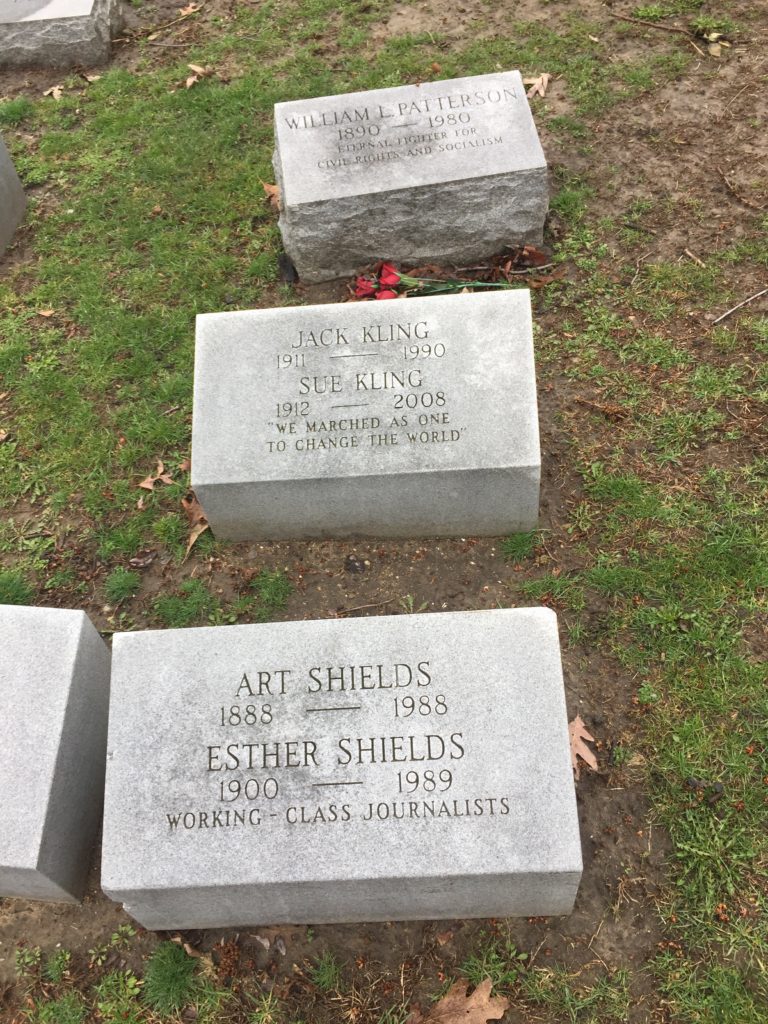Erik Visits an American Grave, Part 583
These are the graves of William Patterson, Jack and Sue Kling, and Art and Esther Shields.

William Paterson was born in 1890 or 1891 in San Francisco. His father was an immigrant from St. Vincent and his mother a former slave. He mostly grew up without his father, who was a missionary for the Seventh-Day Adventists, mostly working in Tahiti. The family stayed in California. He was interested in racial politics from the time he was a child, stating initially that he wanted to be the next Booker T. Washington. He started working as a teen, on the railroads and on boats. He actually managed to save money to attend the University of California-Berkeley, but already attracted to radical politics, he was expelled for refusing to engage in the university’s required military training when the U.S. entered World War I. Still, he pressed ahead and attended law school at Hastings College of Law. He graduated in 1919 but failed the bar. Discouraged with the racism he faced in the U.S., he decided to emigrate to Liberia. He never made it farther than England and decided to come back to the U.S., where he found work as a longshoremen in New York.
New York was good for Patterson. He managed to pass the bar there and got involved in the Harlem Renaissance. He became friends with Richard Moore, a black communist involved in the Sacco and Vanzetti defense. He convinced Patterson to use his legal skills as part of the defense team. This began Patterson’s turn toward communism. Soon he headed the CP’s International Labor Defense organization. He would remain involved in these issues for the rest of his life, working on CP projects through the Great Depression and after. In 1951, he presented to the United Nations a document titled, “We Charge Genocide,” which charged the U.S. with genocide for doing nothing about the lynchings of black people through the nation for decades.
This was mostly dismissed in the U.S. as a commie plot as the Cold War deepened, but was actually very influential internationally, helping to shape attitudes toward American racism in the emerging nations in Africa and Asia and becoming a big deal for the U.S. to deal with. In fact, the Cold War would long shape the civil rights movement, as the racism against black people in the U.S. would be a hugely negative influence in American relationships with the Global South and helped force the hand of Eisenhower, Kennedy, and Johnson to slowly do something about it, not because they necessarily cared that much about violence against African-Americans, but because this was the best possible propaganda for the Soviets because it was also true. So “We Charge Genocide” might well be Patterson’s greatest contribution to humanity. In 1940, he married Louise Thompson, Langston Hughes’ important collaborator, but she is not buried with him, having outlived him by nearly 20 years. He died in 1980 and she lived until 1999.
Jack Kling was born in New York and started work as a furrier at the age of 15. He became a communist and was a Young Communist League leader. Jack was the treasurer of CPUSA at some point. They actually met after Jack had his head beaten in by the cops and Sue was impressed by his commitment. Sue was from Chicago, grew up speaking Yiddish, and started moving left herself before she met Jack. They traveled to the Soviet Union many times after their marriage in the 1930s. Jack was in hiding to avoid arrest for five years in the 1950s, having clandestine meetings with Sue and their children about once a month, but she was mostly left to keep things going with the family. She made that work as a bookkeeper to pay the bills. She also published a lot of leftist poetry published in communist journals. Jack led the CPUSA’s Jewish Affairs Commission for many years. He published an autobiography titled Where the Action Is. Sue published what is claimed to be the first biography of Fannie Lou Hamer. Jack died in 1990 and Sue in 2008.
Art Shields was born in Barbados to Moravian missionaries. He joined the IWW as a young man and wrote many articles for Wobbly newspapers. Like many Wobblies, he converted to communism after the success of the Soviet Union and the repression of the IWW after World War I. He was a longtime journalist with The Daily Worker, covering many of the most prominent strikes of the classic period of American labor organizing. He eventually moved to the Soviet Union late in life and died there at the age of 99 while working on his autobiography. Esther Shields was a rich girl from an exclusive Massachusetts family. But she also rejected her past by the time she was a young woman. She gradated from UC-Berkeley, and also went into journalism. She was a huge fighter for women’s rights, going beyond just the suffrage. She believed marriage was a bourgeois institution that needed to be destroyed, so even though she took Art’s last name, she never actually married him. She also published widely in communist periodicals and was forced to testify in front of the House Un-American Activities Committee in 1956, part of the red-hunting that personified that horrible era. He died in 1988 and she in 1999.
All of these communists are buried in Forest Home Cemetery, Forest Park, Illinois.
If you would like this series to visit other American communists, you can donate to cover the require expenses here. Max Yergan is in Valhalla, New York and Clara Lemlich is in West Babylon, New York. Previous posts in this series are archived here.
